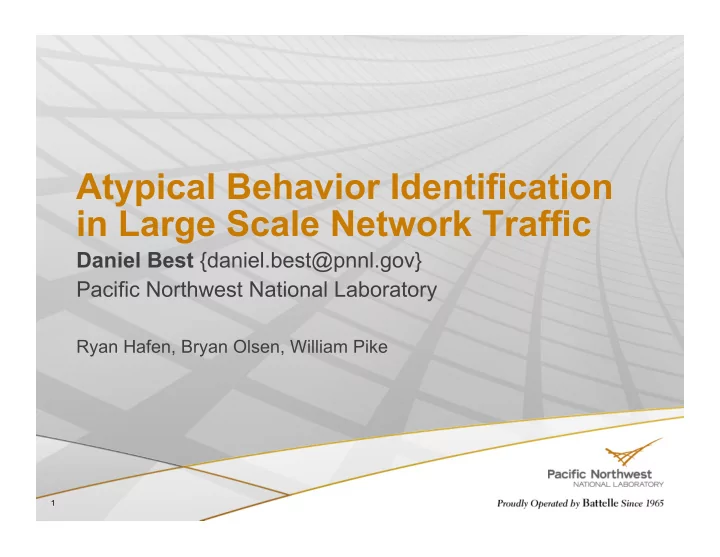

Atypical Behavior Identification in Large Scale Network Traffic Daniel Best {daniel.best@pnnl.gov} Pacific Northwest National Laboratory Ryan Hafen, Bryan Olsen, William Pike 1
Agenda � Background � Behavioral algorithm � Scalable data intensive architectures � Visualization � Future directions 2
What is large scale network traffic? � Most enterprises use some kind of continuous traffic monitoring . � Captured in either pcap or network flow format � Network flow is a summarization of network communication � Network flow is ubiquitous and voluminous � Groups of computers can easily have thousands of flow records per second � Large enterprises generate billions to tens of billions of flow records per day � src: 192.168.24.244, dest:123.321.184.1, src-port:62826, dest-port: 80, proto: 6, start-dtm: 1131850246948, end-dtm:1131850247948, duration: 235, packet-cnt: 38, byte-cnt: 11383, initial-flg: 2, all-flg: 27 3
Development goals � Provide situation awareness and event discovery in large data sets � Facilitate behavioral modeling and anomaly visualization for streaming network traffic � Be capable of real-time and exploratory mode of investigation 4
How to find atypical behavior? � Application concepts paying attention to three areas � Algorithm : Must be efficient to cope with volume of data � Data Management : Must be able supply data quickly � Visualization : Must provide the user the ability to discern atypical behavior and begin investigation process � Meeting our goals � Operationally demonstrated on a dataset containing 100B flow records � Demonstrated capability to stream network flows at ~3 thousand flows per second on a single desktop computer 5
Atypical behavior algorithm background � Behavioral model based on temporal patterns � Improvement over previous models (SAX: Symbolic Aggregate approXimation) � Operates under the assumption that network flow attributes exhibit cyclical behavior of a weekly periodicity � Exploration has shown this holds well for most protocols � Various attributes can be modeled � Total bytes, total packets, network flow count � Aggregation is necessary for statistical robustness 6
Weekly periodicity Take median to form baseline
Comparing current activity to historical trends � Running median calculated for single current series and for m number of historic series � Median absolute deviation (MAD) calculated based on current and historic running medians � MAD and a configurable deviation number used to set upper and lower bounds for current and historic series 8
Current and historic trend overlap NTP 9
Visually encoding overlap with saturation Saturation used to color encode the background of plots 10
Scalable data intensive architectures � Client visualization with various database back-ends � Postgres, Greenplum, Netezza � Needs database driver and appropriate configuration files � Scalability through aggregation � Using summary table (not required), improves performance � Network traffic grouped into categories � Rule based categorization algorithm � Based on attributes available in the data � port, protocol, payload, etc. 11
Primary data architecture focus � Development and research on Netezza � Leverages available hardware and closely resembles the target release architecture � We still remain database agnostic for other deployments � DISTRIBUTE ON Clause � Determines how data is distributed across database appliance (Netezza specific) � Candidate keys should have high cardinality and commonly used in joins � We chose IP address 12
Atypical behavior visualization (Clique) � Behavior baseline for actors � Creates statistical model of what is typical for a given actor and category set � Visualizes the deviation from typical activity � Actor / group hierarchy � Groups of IP addresses, a single IP address, or query based on an attribute � Site > Facilities > Buildings > Individuals � Individually configurable and sharable � Interactive interface provides semantic zooming (LiveRac) � Added adaptive bin widths, deviation highlighting, stability, and database independence 13
Traffic categories Cell (Group & Category) User defined hierarchy Temporal selection 14
15
Future directions � Investigate and implement alternative bottom up approach � statistical model per IP address and aggregation based on that model � Improve interface performance � Investigate alternate middle tier architectures � Enhance applicability by developing prototypes in different domains � Incorporate abrupt outlier identification and visualization 16
How to get in touch Daniel Best @danvizsec daniel.best@pnnl.gov 17
Recommend
More recommend